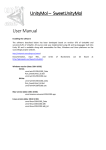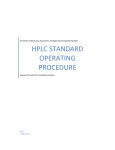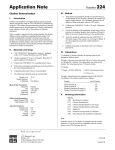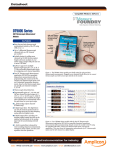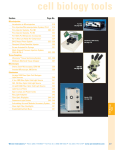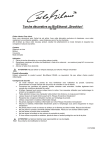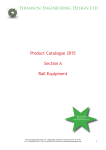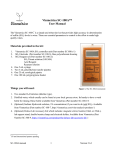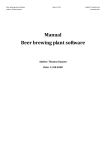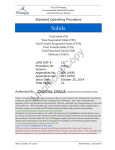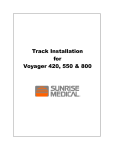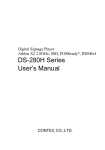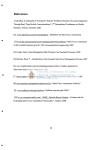Download Rapid Measurement of Xylose and Glucose
Transcript
Application Note Rapid Measurement of Xylose & Glucose Monitoring Corn Stover Fermentation in Bioethanol Production I. Introduction Simultaneous glucose and xylose concentrations can be measured during fermentation of complex matrices such as pretreated corn stover during the production of bioethanol. A measurement can be made in about one minute with minimal preparation using the YSI 2700 SELECT. YSI's enzyme electrode technology provides for specific glucose measurements in the range of 0.05 to 9.00 g/L and for xylose measurements in the range of 0.5 to 30.0 g/L (undiluted). Measurements are virtually unaffected by color, turbidity, density, pH, and most chemical substances. When configured with YSI glucose oxidase and YSI pyranose oxidase membranes, the YSI 2700 analyzer measures glucose and xylose with aspiration of just 13 microliters of sample. Most samples require simple filtration and dilution prior to measurement. Results are displayed using PC-based software 1 . The sample is automatically flushed from the electrode chamber within 30 seconds after results are displayed and the YSI 2700 is ready to measure the next sample. Turn around time per sample is under two minutes. In the study described glucose and xylose were periodically measured in filtered corn stover fermentation samples over a 48 hour period during lab-scale bioethanol production 2 . Some samples required dilution. Results were compared to HPLC runs of the same samples (see results below). The advantage of a simple, fast, and accurate simultaneous glucose and xylose measurement is to provide near real time data for these two key parameters. Timely information related to the progress of sugar fermentation may help researchers improve ethanol yield. II. Materials and Setup Sample Collection Number 328 YSI 2700 Instrument Setup See the YSI 2700 user’s manual for general setup and safety information. Chemistry electrode and reagent configurations depend on dual channel operation. The YSI 2700 in its current configuration does not have ‘xylose’ programmed into the setup menu. To run these two chemistries simultaneously follow the setup information outlined below. Under Menu choose Setup, and then choose MeasParam to access the electrode assignment configuration. Set/confirm the following parameters. Sample Size Cal Method 13 microliters Two Station Black Probe Parameters Chemistry Unit Calibrator End Point CalStation# Peroxide (Xylose) 3 g/L 20.0 30 seconds 2 White Probe Parameters Chemistry Unit Calibrator End Point CalStation# Dextrose (glucose) g/L 2.50 30 sec 1 Autocal Parameters 4 Sample Error Temperature Time Sample Cal Shift Calibration Station(s) Sample Station ON 1°C 0 Min 5 0 Sam 2% #1 (glucose); #2 (xylose) #3 (or #4 if turntable) III. Method Collection container (appropriate volume for fermentor sample) Whatman #2 filter paper, funnel and collection vessel Nylon syringe filter (0.22 micron); 3 ml luer lock syringe Collection tubes (1.5 or 2.0 ml microcentrifuge tube) YSI 2700D, configured for glucose & xylose measurement PC with spreadsheet software (e.g., Microsoft® Office Excel) Alternatively, PC with LabView™ user-interface software A. Calibrate the YSI 2700 by entering Run Mode or, if in Run Mode, by pressing the Calibrate key. B. Each day, prior to runs, perform the FCN membrane test using YSI 2363 solution. C. Each day, prior to runs, test the linearity of the system with YSI 1531 (9.00 g/L glucose) linearity standard; followed by running a second linearity test with 30.0 g/L xylose linearity standard. Record only the displayed value for the chemistry you are testing. 3 Xylose is not currently a choice in MeasParam setup. Select ‘Peroxide’ for this application. 1 YSI PC-based software automatically compensates for glucose/xylose measurement interactions. Alternatively, YSI- displayed results may be manually entered into a customized spreadsheet program available as a free download from www.ysilifesciences.com. See user guide for details. 2 YSI greatly appreciates the contributions of Nancy Dowe and her team at the National Renewable Energy Laboratory, US DOE, Golden, CO. 4 Enter AutoCal menu from RunMode under Setup Menu. 5 Automatic calibration is disabled. The YSI PC-based algorithm directs calibration for simultaneous glucose & xylose measurement. If performed manually, follow instructions in the Calibration Instruction Sheet. 1725 Brannum Lane PO Box 279 Yellow Springs, Ohio 45387 USA 937.767.7241 • 800.659.8895 • www.ysilifesciences.com • [email protected] Page 1 of 4 A27328A 10/2008 B80 D. If using the manual spreadsheet entry protocol, next run each calibration solution as a sample. Record the nA PL currents for each electrode and for each solution and enter the 4 values IXx, IXg, IGx and IGg. These values are recorded in a spreadsheet (see Page 4). E. When idle for more than 30 minutes during sampling or after running 5 samples, initiate a calibration to ensure greatest accuracy. F. Collect sample from the fermentation vessel, ensuring a representative sample. G. Filter the sample using Whatman #2 paper to eliminate the bulk of the particulate matter. Collect the filtrate. H. If necessary, dilute the sample with reagent water. Record dilution factor. (See Page 4 regarding sample dilution.) I. If also running samples for HPLC comparison, check pH using a test strip. Add 1% NH4OH solution to adjust pH to ~7. Record volume of base added 6 . J. Mix samples well and remove at least 2 ml using a clean, disposable 3 mL syringe for each. K. Secure a 0.22 µ filter cartridge to the luer fitting and dispense the sample into a microcentrifuge tube. This step eliminates small particulates and virtually all cells. L. M. N. V. Results Seven samples over a 48-hour fermentation of acid-hydrolyzed corn stover where collected and filtered. The samples were collected at 0, 4, 8, 12, 24, 32 and 48 hours to monitor xylose and glucose consumption (main sugars from the acid hydrolyzate). Split samples from each collection time were measured by HPLC 8 configured for a sugar profile, and by the YSI 2700 configured for simultaneous xylose and glucose measurement. The results of a representative run are displayed in Table 1. Samples T-0 and T-4 were diluted ten-fole and two-fold, respectively, to bring the signals within reportable ranges for xylose. The results from diluted samples were back calculated. From HPLC data, samples were known to contain several sugars that are potential interferences for the pyranose oxidase membrane. These are Arabinose, mannose, galactose and cellobiose. None were found to have a significant effect on the xylose reading. In the corn stover matrix studied glucose and xylose are by far the dominant sugars from saccharification and YSI values tracked HPLC results very closely. Sample Glucose (g/L) Xylose (g/L) (hours) HPLC YSI bias HPLC YSI bias T-0 21.8 20.1 -1.7 53.8 57.4 +3.6 T-4 3.3 2.1 -1.2 38.4 34.5 -3.9 T-8 1.1 0.5 -0.6 22.0 23.3 +1.3 T-12 0 0.3 +0.3 13.5 13.1 -0.4 T-24 0 0.2 +0.2 7.0 7.0 0.0 T-32 0 0.1 +0.1 6.6 6.5 -0.1 T-48 0 0.1 +0.1 6.1 5.9 -0.2 7 Present the sample to the YSI 2700 for measurement using Station #4 (turntable) or #3 (manual presentation). Record the glucose and xylose nA PL probe currents displayed or printed by the 2700. Enter values into the spread-sheet software provided, Rx for xylose electrode and Rg for glucose electrode PL currents. Record the glucose and xylose corrected concentrations from the spreadsheet software; adjust with calculations for dilutions, as necessary. Table 1: Data from Run 072707 at NREL IV. Calculations Glucose & Xylose - Corn Stover Fermentation Samples that were diluted must be back-calculated by the dilution factor. Cross signal interference between glucose and xylose probes are automatically corrected using YSI-provided software. 70 HPLC xylose 60 YSI xylose Sugar, g/L 50 To provide the most reliable results the YSI electrode signals were recorded for both calibration data and for sample concentrations. The net nA (nanoamperes) signal values were obtained from the detailed printouts of the YSI 2700 and entered into the YSI software as described in the Calibration Instruction Sheet. Each calibration was run three times to ensure stability before samples were run. Each sample was run in triplicate to verify precision in the measurement. Averages of samples were used to derive the values shown in the tables and graphs. HPLC glucose 40 YSI glucose 30 20 10 0 0 10 20 30 Time, hrs 40 50 60 Figure 1: YSI vs. HPLC – Depletion over 48 Hours 6 The pH adjustment step is required only for HPLC measurements in this study. The YSI measurement is quite tolerant of samples from pH 4 to 9. 7 An aliquot of this same sample was run by HPLC to obtain a reference value for comparison to YSI glucose and xylose values. Glucose was depleted within 10 hours while xylose depletion did not reach completion. Concentrations of both sugars were relatively stable within 24 hours of the start of fermentation. 8 Hewlett Packard 1100 with RI detector, Shodex SP0810 column; HPLC grade water mobile phase; 10-50 µL sample; 0.6 mL/min flow; 85°C. Page 2 of 4 Application Note Number 328 Correlation Plots of YSI vs. HPLC for Glucose and Xylose Correlation data are plotted using values from Table 1 and the results obtained in the repeat run two weeks later at YSI. Therefore each concentration point contains two sets of data. In the preliminary investigation presented above glucose and xylose concentrations proved to correlate well with HPLC results when compared in aliquots of the same samples. Concentrations were compared periodically over the 48-hour fermentation as shown in Figure 1. Although relatively few samples were studied good correlation was observed as shown in Figures 2 & 3. Glucose from Corn Stover Fermentation - YSI vs. HPLC 25 20 y = 0.9033x - 0.0866 2 R = 0.9957 g/L YSI 15 10 5 0 0 5 10 15 20 25 -5 g/L HPLC YSI Part Numbers: 2700D Biochemistry Analyzer 2365 Glucose Oxidase Membrane Kit 2761 Xylose Membrane Kit 2357 Buffer Kit 2776 Glucose/Lactate Calibrator (2.50 g/L glucose) 1531 Glucose Linearity Test Standard (9.00 g/L) 2767 Xylose Calibrator (20.0 g/L) 2768 Xylose Linearity Test Standard (30.0 g/L) 2363 Potassium Ferrocyanide Test Solution 2392 NaCl Solution (for membrane installation) Xylose from Corn Stover Fermentation - YSI vs. HPLC 70 y = 0.9937x - 0.2523 2 R = 0.9852 g/L YSI 50 In conclusion the YSI 2700 can be used to monitor glucose and xylose to gain valuable information relevant to maximizing ethanol production efficiency. The YSI technology allows users to collect more data during critical time windows to help better understand process conditions, and in some cases could allow users to adjust process conditions during the fermentation. The technology is applicable to bench-scale, pilot-scale and production scale uses. VII. Ordering Information Figure 2: YSI vs. HPLC – Glucose during 48-hour Fermentation 60 The YSI 2700 configured for xylose and glucose provided results with relative ease of use, speed and accuracy compared with HPLC. Since the YSI is also known to tolerate samples of a broad pH range and show little or no effect to color and turbidity, it provides an excellent complementary method to HPLC when monitoring fermentations using lignocellulosic biomass. 40 30 20 10 VIII. Related YSI Application Notes 0 0.0 10.0 20.0 30.0 g/L HPLC 40.0 50.0 60.0 Figure 3: YSI vs. HPLC – Xylose during 48-hour Fermentation Rapid Measurement of Residual Ethanol in Corn Stillage (Beer) during Distillation (Note # 326) Rapid Measurement of Glucose during Fermentation in Bioethanol Production (Note #327) VI. Discussion Lignocellulosic biomass has been widely studied as a feedstock for fermentation in fuel ethanol production. For example, acidtreated corn stover produces a variety of fermentable sugars that include glucose, xylose, mannose, arabinose, cellobiose, and galactose. Carbohydrate profiles from HPLC analysis showed that glucose and xylose in initial feedstock represent more than half of all carbohydrates in the acid-hydrolyzate; and for that reason can be important markers to evaluate the progress and efficiency of the fermentation process. HPLC is currently the most common method used to measure glucose and xylose, along with other key metabolites during the production of ethanol. HPLC is quite accurate and precise but is based on separation technology and optical-based measurements that require significant pretreatment of the sample. In addition, time to results after pretreatment may be 30 minutes or more. 1725 Brannum Lane PO Box 279 Yellow Springs, Ohio 45387 USA 937.767.7241 • 800.659.8895 • www.ysilifesciences.com • [email protected] Page 3 of 4 A27328A 10/2008 B80 IX. Dilution of Samples X. As with most analytical methods there is a concentration range that provides optimal accuracy and precision. The YSI xylose and glucose methods are specified independently for performance; however these two analytes frequently occur together. Since there is cross-signal interference between the glucose and xylose electrodes compensation equations are applied in mixed solutions of glucose and xylose. In some cases the combined signals exceed the linear range of one or both electrodes. In this situation dilution of sample is recommended to improve accuracy of results. We offer several options to measure xylose and glucose with the YSI 2700. Selected results from the detail printout of the 2700 provide the information you need to calculate glucose and xylose concentrations; and provide dilution equations if necessary. The Microsoft Excel™ file can be downloaded at no cost from www.YSILifeSciences.com. YSI has developed a software tool that helps you to assess the need for dilution in your sample. If you provide an estimate of the expected glucose and xylose concentrations in your sample, the software automatically calculates an appropriate dilution factor. This tool improves the reliability of the result while saving you time and effort to perform trial dilutions. Please see the steps below and refer to the user’s manual for more detail. The dilution equations may be downloaded from the YSI Life Sciences’ website. Do the following to determine if sample dilution will improve your results. 1. Enter the calibration PL currents (nA) for each electrode and for each analyte. The information appears on the YSI 2700 printout. These four values must be entered into the downloaded spreadsheet. First enter IXg and IGg, glucose at the xylose electrode and glucose at the glucose electrode, respectively. Then enter IXx and IGx, xylose at the xylose electrode and glucose at the xylose electrode, respectively. 2. Enter the best estimates of the xylose and glucose in gram/liter concentration units for your sample. The optimal dilution factor will be displayed. You may round that value to create a whole number to simplify the dilution protocol. Manual Entry from YSI 2700 Printouts When you determine if dilution of sample is necessary you may continue to use the data from the 2700 print report to determine the glucose and xylose concentrations. Enter the Rg and Rx values in the fourth box down in the dilution template shown in Figure 4. The final results for xylose and glucose, including correction for dilution, are shown in the lowest boxes of the template. The results appear in g/L concentration units. XI. Remote Control with LabView™ Software Alternatively, YSI offers PC-based software. Using a custom interface cable available from YSI Life Sciences the YSI 2700 can be operated remotely from a PC to command calibrations and samples. Results of sample runs are displayed on the PC and stored in files that the user manages. See the main user-interface below. Figure 5: LabView™ User Interface Screen The dilution factor may be entered on the user interface screen. As samples are run by the 2700 the program automatically displays the results, corrected for dilution as required. Refer to the YSI 2700 User Guide for more detailed information. Figure 4: Dilution Calculator Template When you determine if dilution of sample is necessary you may continue to use the data from the 2700 print report to determine the glucose and xylose concentrations. In the template the Rg and Rx values are entered in the fourth box down. The results, adjusted for dilution, appear in the fifth and lowest box shown in Figure 4. Page 4 of 4





